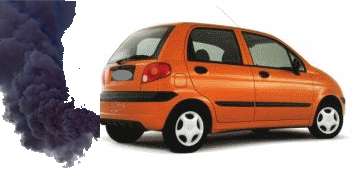Smoke from the exhaust on my car
Our car is constantly expelling gases through the exhaust pipe and recognize our responsibility to know what type of gases and / or fumes are coming out of the engine to take corrective action if necessary.
When the engine of our car is in good working condition or new, the exhaust basically ejects water vapor (H20), carbon monoxide (CO), carbon dioxide (CO2) and other substances in smaller proportion: particles coal, gasoline in extremely small proportions, nitrous oxide (NOx).
When starting the engine in the morning-or cold climates may notice steam coming out, and we identify it as a small transparent cloud and disperses immediately leaving no trace of odor.
As the engine and vehicle miles of travel accumulating presenting will wear on moving engine parts but we have successfully done oil changes and in due time, this wear is normal in any car engine.
As a result of wear in the cylinders of the combustion chambers and their pistons, wheels and other parts, starts filtering the lubricating oil from the engine to the combustion chamber, where it is burned along with the gasoline / air , producing smoke in the exhaust with a strong odor that attracts our attention, and depending on the major or minor leaks into the combustion chambers will disappear after about 5 minutes of operation of the motor when the leak is small, or stay as long as we accelerated and increased if the leak is higher.
Use of additives in motor oil to reduce smoke emissions

Available on the market a number of products reducing smoke emissions tailpipe of our cars .
But we always have that question : When should I or I can I use a smoke reducing additive in my car?
Well to make the decision whether to use a reducing additive or smoke -smoke (Smoke reducer, Smoke Treatment in English, and are labeled as if all the bottles of these additives ) , we should know how it will affect us function and operation motor.
Every time we change engine oil do it for several reasons: the most important is that the oil has lost its lubricating properties and its viscosity, which is the property of flow through all parts of the engine to provide lubrication and reducing wear .
As mentioned above the oil filter to the combustion chambers by small gaps, and the amount of oil that pass through these gaps will be lower if the OIL VISCOSITY IS HIGHER , and with this we come to mind that the additive anti-smoke is one simplmente LIFT OIL VISCOSITY .
Obviously the higher the viscosity is less smoke emission from the exhaust pipe , but that's where things fail . As the viscosity of engine oil goes lower and therefore LUBRICATION wear increases.
This is where we must carefully manage the anti-smoke additive because we can generate a lot of wear parts of our engine.
I recommend for the above use a smoke reducing additive wisely and for short periods , say a few weeks that will give us time to find a solution and we understand that , for example ONLY change the gasket cylinder head gaskets and valves or on the other hand if the mileage is greater than about 200,000 km is recommended to change the piston rings over head gaskets and valve seals with a possible correction of the cylinders.
White smoke , blue smoke , black smoke from the exhaust pipe
To properly diagnose the type of damage that has the engine of our car we should pay attention to the color of the smoke from the tailpipe .
If the smoke from the exhaust is white is indicative of what's going liquid cooling or water cooling system into the combustion chambers , and this happens when the head gasket is damaged cylinders .
If the smoke from the exhaust is blue indicates that engine oil is going into the combustion chambers , either the valve seals , head gasket or pistons wheels .
In these two cases need to disassemble the engine and replace the seals, gaskets and damaged packaging.
However if the smoke coming out of the exhaust pipe is black is a sign that IS NOT COMPLETE COMBUSTION , so you have to tune the engine.
It is common after repair of this engine smoke emission , so it is necessary to give time for the engine to products during handling might have to enter the combustion chambers to burn , but if the problem persists after a few days is a sign that something was improperly installed or adjusted , such as no cylinder heads properly torquing .
